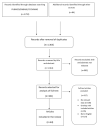Skin Manifestations after Ionizing Radiation Exposure: A Systematic Review
- PMID: 34821719
- PMCID: PMC8614920
- DOI: 10.3390/bioengineering8110153
Skin Manifestations after Ionizing Radiation Exposure: A Systematic Review
Abstract
Morphological and functional skin alterations secondary to the action of ionizing radiation are well documented. In addition to its application in the medical field, ionizing radiation represents a public health problem for diagnostic and therapeutic purposes due to the potential risk of exposure to unexpected events, such as nuclear accidents or malicious acts. With regard to the use of ionizing radiations in the medical field, today, they constitute a fundamental therapeutic method for various neoplastic pathologies. Therefore, the onset of adverse skin events induced by radiation represents a widespread and not negligible problem, affecting 95% of patients undergoing radiotherapy. A systematic literature search was performed from July 2021 up to August 2021 using PubMed, Embase, and Cochrane databases. Articles were screened by title, abstract and full text as needed. A manual search among the references of the included papers was also performed. This systematic review describes the various skin reactions that can arise following exposure to ionizing radiation and which significantly impact the quality of life, especially in cancer patients.
Keywords: radiation dermatitis; radiation exposure; skin manifestations.
Conflict of interest statement
The authors declare no conflict of interest.
References
-
- Frane N., Bitterman A. Radiation Safety and Protection. StatPearls Publishing; Treasure Island, FL, USA: 2021. - PubMed
-
- López E., Guerrero R., Núñez M.I., del Moral R., Villalobos M., Martínez-Galán J., Valenzuela M.T., Muñoz-Gámez J.A., Oliver F.J., Martín-Oliva D., et al. Early and late skin reactions to radiotherapy for breast cancer and their correlation with radiation-induced DNA damage in lymphocytes. Breast Cancer Res. 2005;7:R690. doi: 10.1186/bcr1277. - DOI - PMC - PubMed
Publication types
LinkOut - more resources
Full Text Sources


